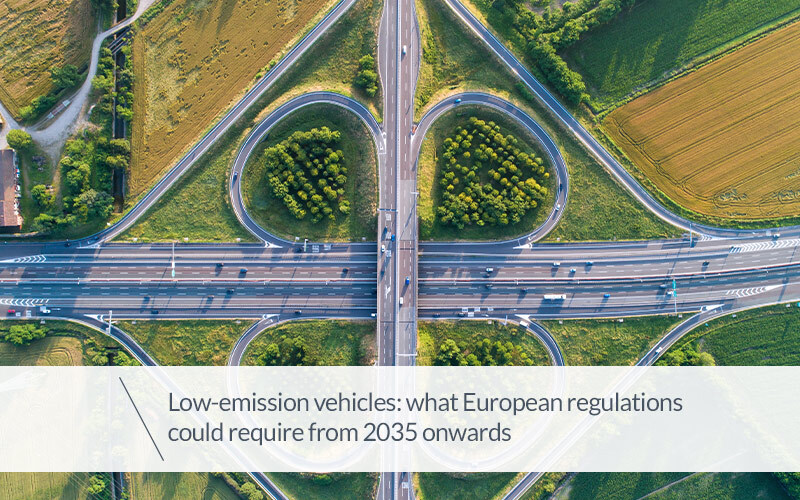Low-emission vehicles: what European regulations could require from 2035 onwards

The European Union has established ambitious targets for cutting greenhouse gas emissions, committing through the European Green Deal, voted by the EU Parliament in 2020, to reduce net emissions by at least 55% from 1990 levels by 2030 and to achieve climate neutrality by 2050. Achieving these goals requires a major transformation, particularly within the transport and automotive sectors.
The EU internal market requires the free movement of goods, persons, services and capital, and a common vehicle emission standard is essential to ensure a fair and competitive market.
The automotive industry is navigating a period of significant change, addressing challenges such as supply chain adjustments, fluctuations in energy and raw material costs, and adapting to new regulations.
To facilitate this transition and support the move toward a low-emission future, the EU has introduced measures such as the Euro 7 standards and the 'zero emissions' target set for 2035, providing a framework for progress and innovation.
Euro 7
Euro 7, proposed by the European Commission in November 2022 and adopted in April 2024, aims to further reduce pollutant emissions from motor vehicles, improving air quality and protecting human health and the environment.
It applies to a wide range of vehicles - including those in categories M1, M2, M3, N1, N2 and N3 (M refers to motor vehicles intended for the transport of persons, N to those destined for the transport of goods), as well as trailers in categories O3 and O4 - and introduces several significant innovations compared to the previous Euro 6/VI standards:
- Tighter emission limits for air pollutants, including:
- Carbon monoxide (CO)
- Total hydrocarbons (THC)
- Non-methane hydrocarbons (NMHC)
- Nitrogen oxides (NOx)
- Particulate matter (PM)
- Number of particles (PN)
- Ammonia (NH3)
- Methane (CH4)
- Nitrous oxide (N2O)
- Introduction of emission limits for formaldehyde (CH2O) for vehicles in categories M2, M3, N2 and N3 from 2030, following a review.
- Extension of emission tests to more driving conditions, including low-temperature, uphill, and real driving conditions (RDE).
- Introduction of new requirements for the durability of anti-pollution systems to ensure that vehicles continue to comply with emission limits for a longer period, corresponding to the expected average lifetime of vehicles in the EU.
- Introduction of new requirements for on-board monitoring systems (OBM) to improve the ability to detect malfunctions of anti-pollution systems.
- Introduction of battery durability requirements to ensure that electric vehicle batteries maintain sufficient capacity for a significant period.
- Tyre abrasion measurement to limit particulate emissions from tyre wear.
Euro 7 rationalises and simplifies the existing Euro standards, bringing together in a single regulation the provisions previously contained in two separate regulations for light and heavy vehicles.
It also introduces new security provisions to limit tampering and cybersecurity measures.
The effective implementation dates of the Euro 7 regulation have been postponed compared to the initial proposal, which envisaged entry into force on 1 July 2025 for categories M1 and N1 and 1 July 2027 for categories M2, M3, N2 and N3. At present, entry into force will take place at staggered times, depending on the vehicle category:
- 29 November 2026: will come into force for new types of cars and vans (categories M1 and N1).
- 29 November 2027: will apply to all new registrations of cars and vans.
- 29 May 2028: will come into force for new types of buses, trucks and trailers (categories M2, M3, N2, N3, O3 and O4).
- 29 May 2029: will apply to all new registrations of buses, trucks and trailers.
- Vehicles produced by small series manufacturers (less than 10,000 passenger cars or 22,000 vans per year) will be affected by the regulations as of 1 July 2030 for categories M1 and N1 and as of 1 July 2031 for categories M2, M3, N2 and N3.
The 'zero emissions' target from 2035
As previously mentioned, the European Union has set itself the ambitious goal of achieving climate neutrality by 2050, with an important intermediate target of reducing net greenhouse gas emissions by at least 55% compared to 1990 levels by 2030.
To achieve this, the transport sector, which is responsible for 25 per cent of greenhouse gas emissions in the EU (road transport accounts for 71 per cent of the sector's total), must be significantly decarbonised.
To this end, the EU has introduced a zero-emission target from 2035 for new passenger cars and light commercial vehicles, enshrined in Regulation (EU) 2023/851.
This regulation stipulates that, from 1 January 2035, all vehicles in these categories registered in the EU must have zero CO2 emissions.
This decision represents a decisive turning point for the European automotive industry, which will have to accelerate the transition to the production of zero-emission vehicles:
- battery electric vehicles (BEVs);
- fuel cell-powered vehicles (FCEVs);
- other hydrogen-powered vehicles.
This goal has been welcomed by many, including public authorities, NGOs and environmental organisations, who see it as a necessary step to combat climate change. However, some car manufacturers have expressed concerns about the speed of the transition and the need for adequate support for the industry, through a letter from the European Automobile Manufacturers' Association (ACEA) to EU leaders, dated 16 January 2025.
The European Commission has recognised the importance of accompanying the industry in this transformation by providing a series of support measures, including:
- incentives for research and development of zero-emission technologies;
- financial support for the conversion of industries and workers in the automotive sector;
- promotion of a competitive market for zero-emission vehicles through the creation of recharging and refuelling infrastructures.
The European Commission will monitor progress towards the target and submit regular reports to the European Parliament and the Council, also assessing the need for additional measures to facilitate a fair transition.
It is important to emphasise that the zero-emission target from 2035 only concerns newly registered vehicles. Internal combustion engine vehicles already in circulation will still be permitted to circulate, but their share of the market is expected to decrease gradually, partly due to the introduction of stricter standards for pollutant emissions like Euro 7.
However, the path forward is not without its complexities. Significant uncertainties remain regarding the practical implementation and enforcement of these regulations. Questions persist about the ability of manufacturers to adapt production processes within the given timelines, the readiness of infrastructure to support widespread adoption of zero-emission vehicles, and the potential economic implications for consumers, particularly in regions where access to affordable alternatives is limited.
These uncertainties could lead to further refinements or adjustments in the regulatory framework to ensure the transition is both effective and equitable. Balancing environmental goals with economic and technological realities will require ongoing collaboration between policymakers, industry leaders, and other stakeholders as the automotive sector navigates this pivotal shift toward sustainability.



